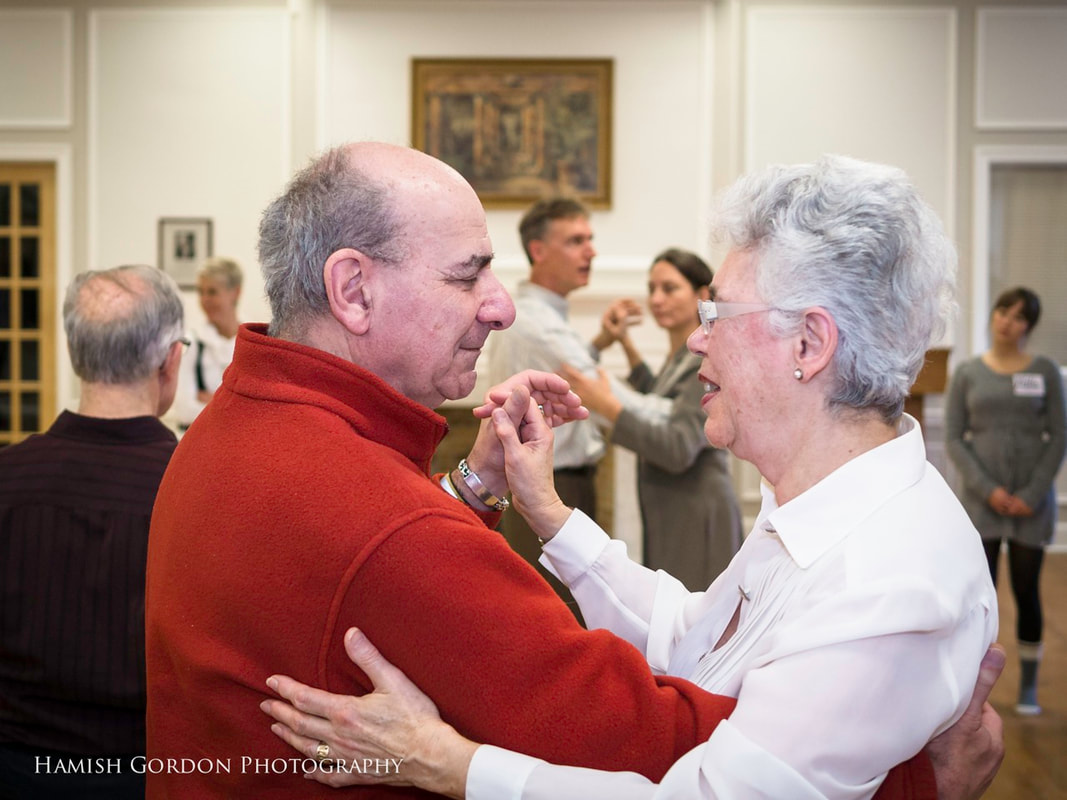|
It has been known for many years that many forms of dance and movement (including simply walking) have significant health benefits. Over the last ten years, researchers have discovered that Argentine tango is particularly beneficial in many ways. Studies have shown improvements in areas ranging from balance, gait and posture to mood and social engagement. Several features of the tango are thought to contribute to its therapeutic effects. For a start, the embrace offers a gentle, flexible touch (as opposed to a rigid, stylized frame) which is in itself beneficial. It allows partners to support each other gently while they gain confidence in stepping—especially backwards, which is often challenging for seniors and those with any neuromotor difficulties. The non-verbal communication through the embrace may be especially valuable. The fact that tango is based on walking makes it accessible to many who find other dance forms too challenging. The tango walk itself helps develop balance and a regular gait, while learning short combinations or figures is excellent for memory. The pivot, the second basic element of tango, is another valuable exercise for anyone with challenges in balance and turning. Last but not least, tango music is highly expressive, with a wide variety of moods and feelings which can be shared by the partners through the embrace and movement. All these reasons and more make tango good for you—come join us and explore for yourself! Benefits of Argentine tango for adults with neurological conditions
Argentine tango is an improvised, gentle activity based on walking. For individuals with motor impairments, balance and posture during walking are facilitated by the support of a partner who contributes to the mechanics of the dance. In Argentine tango, each weight shift and step is led and followed, and a unique embrace is used for nonverbal communication between dance partners. Partners are challenged to attend to the physical cues of the other dancer in order to follow the pattern of their steps: forward, to the side, to the back, or across the body. Leaders and followers alike are challenged to develop their own ways of moving in synchrony with the music and with their dance partners. Physical considerations Because Argentine tango is a gentle form of physical engagement based on walking, anyone who is able to walk can execute this dance. Individuals with low mobility, low confidence in movement, or fear of falling can gain confidence in movement from successful participation in this activity, while simultaneously improving gait, balance, posture, and motor patterning. For the purposes of this pilot project, Argentine tango will be investigated as a tool for improving balance, gait, confidence, and enjoyment of music in individuals with neurological conditions who are attempting to maintain or regain healthy gait mechanics, and coordination and strength of the lower extremities. Cognitive considerations Argentine tango encourages dancers to focus on the stability and movements with a partner, as well as the characteristics of music, and the positions of other couples around them. The activity challenges creativity, executive functioning, and working memory; encouraging participants to plan several steps ahead, and to communicate their movement intentions non-verbally to a partner, focussing on the planning, intention, and execution of each step. The brain is trained to multi-task, at a rate which can be determined and adjusted by individual dancers rather than by an external instructor. Social considerations The tango embrace fosters caring, support and respect for one’s partner, and is not controlling or rigid as in some other styles of social dance. The complexity and beauty of tango music encourages participants to feel emotions and to share them nonverbally through dance, which can be especially valuable for individuals who experience social isolation or have difficulty communicating with words. The rotation of partners and roles in tango creates bonding, equality, and a sense of community among dancers of all levels. The environment of a dance hall provides a welcome alternative and non-medical atmosphere in which participants need not be identified by illness or impairment, and in which they are free and encouraged to explore new desires and skills. Comments are closed.
|
You, Two, Can Tango! © 2023 All Rights Reserved.
AuthorMartina & Lorne Archives
April 2015
Categories |

 RSS Feed
RSS Feed